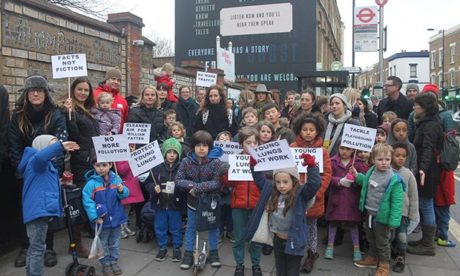Campaign group casts doubt on accuracy of council’s air quality monitoring

A group campaigning for clean air for Hackney’s schools has cast doubt on the accuracy of the Town Hall’s air quality monitoring figures.
CleanAir4Schools measured the distances between monitoring devices and a small sample of Hackney schools with architectural laser equipment and found that they differed from those listed in the council’s 2017 air quality report, in one case by a distance of 44 metres.
The campaign group claims that a matter of metres in the placement of monitoring devices can make the difference as to whether a school breaches legal limits on air pollution.
Environmental scientist and CleanAir4Schools campaigner Tom Knowles said: “In terms of proximity to the road, even a metre makes some difference. Walking on another side of the road can make a difference to exposure.
“Overestimating the distance from the device to the building becomes important, because it allows pollution to dissipate in a pollution model, and therefore underestimates the risk to what they call the receptors, in other words the people in the building, the children in the school.
“We know they are checking the devices monthly, so you’d think someone would have made a very accurate measurement at some point.”
According to CleanAir4Schools’ measurements, the distances overestimated by the council include:
- 44 metres at Princess May Primary (out by 142 per cent)
- almost five metres at William Patten (out by 37 per cent)
- two metres at St Mary’s Primary (out by 17 per cent)
The alleged errors, which have only just been spotted, are included in the London Borough of Hackney Air Quality Annual Status Report 2017, which was published in May last year.
The report, which is the most recent data on air quality monitoring to be made public by the council, lists a further 149 sites where measuring devices have been placed.
CleanAir4Schools is now calling for an independent study into pollution at all Hackney schools, as well as for the council to actively reduce traffic on Stoke Newington Church Street.
Campaigner Sally Newsom said: “We thought the council’s measurements looked way out so we measured it ourselves. We were horrified by the results.
“Those in positions of power and with responsibility for the welfare of our children are failing to represent the true picture of pollution at local schools and, in doing so, they’re putting children’s health at risk.”
The campaign group and the Town Hall last clashed when CleanAir4Schools research showed that Hackney’s interpretation of Department for Environment, Food and Rural Affairs (Defra) air quality guidance differs from 23 other local authorities and City Hall.
Out of two different measuring standards for air pollution set by Defra, Hackney has said it uses an hourly limit of 200µg/m3 up to 18 times per year for school playgrounds, whereas other councils use the more stringent annual mean measurement of 40 µg/m3 of nitrogen dioxide.
CleanAir4Schools has also released its methodology for calculating the distances – measuring with their laser trackers from the monitor to the part of the school which is closest to the road.
Where monitors were set diagonally from schools, they took a straight line measurement to the school façade from the equivalent point in the kerbside to the monitor (in line with the diffusion tube), claiming that a diagonal measurement would “greatly increase the distance and give a distorted picture of pollution drop-off from its source”.
Edit: This article was updated at 16:54 on 15 February- Hackney Council responded to CleanAir4Schools’ claims after this article went to press. Read the story here.
